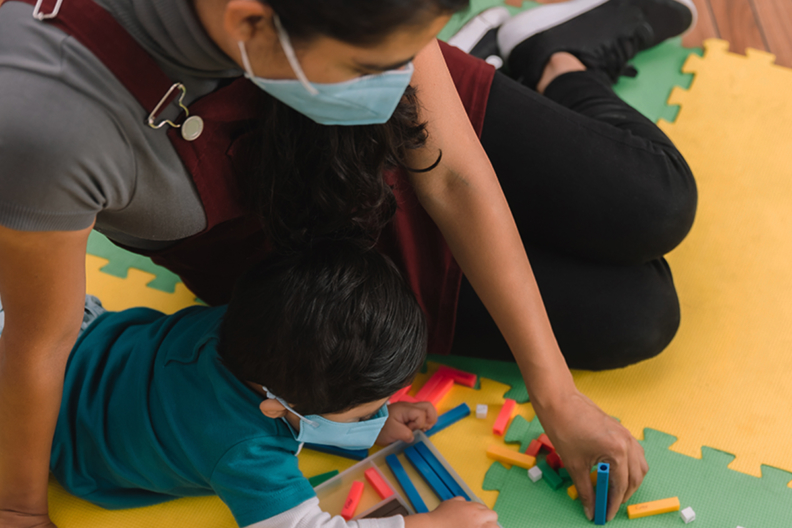Now is the Time for Universal Child Care in NY
Every parent in the country should have a right to quality child care. But there is no reason why our state should wait for Congress or President Biden to act.

When the Build Back Better Act stalled in the U.S. Senate last year, advocates for universal child care suffered a setback. The bill included provisions that would move the country closer to a place where every family could access quality, affordable care, the child care workforce would earn a living wage, and child care providers would be given the support they need to keep their businesses afloat.
But while Build Back Better’s future is uncertain, what is clear is that the current child care system in New York is in crisis. That crisis cannot be met with silence or small policy ideas from our state elected officials. There is a dire need for transformative policy. The governor and the legislature have the chance to build a system that is truly accessible to all New Yorkers, and one which finally recognizes the importance of child care in maintaining a functioning and equitable society.
The ongoing pandemic has highlighted the fundamental failures of our current system. As the Times Union recently reported, two parents with one child can expect to pay about $15,000 for child care. That’s about one-fifth of the state’s median household income. In New York City alone, an estimated 93 percent of families with young children cannot afford center-based care and 80 percent cannot afford somewhat less expensive home-based care.
Women, especially women of color, have suffered irreparable harm due to the absence of a comprehensive state policy. For frontline workers, a disproportionate number of whom are Black and Brown, the lack of accessible child care has been a disaster. Since the very beginning of the pandemic, these workers have been required to go in to their non-remote jobs. For workers with children, this has meant choosing between one of two options: quit work and forgo the funds that keep their families fed and housed, or create a patchwork of care that relies on family, friends, and intermittent sick days, while worrying that they might be fired.
Economists and academics predict that the pandemic has sent the workplace equity goals of women back an entire generation.
For all women, the pandemic revealed what they have known for generations: that caregiving responsibilities fall heavily on their shoulders. As Governor Hochul herself acknowledged, “I was one of those moms who loved my job, who could not find child care, definitely not afford child care, and as a result I had to leave a job that I cared about very deeply.” With schools closed, unpredictable or hybrid schedules, unaffordable and inaccessible child care has only exacerbated historic gender roles.
Even for women fortunate enough to be able to work remotely, trying to care for and educate their children, while fulfilling the requirements of a full-time job, has been overwhelming. Record numbers of women have left the workforce. Economists and academics predict that the pandemic has sent the workplace equity goals of women back an entire generation.
For child care providers, the pandemic showed that the economic model underpinning this sector is so fragile and under-resourced, it is a constant struggle to maintain their businesses. More than a thousand providers have closed their doors permanently during the pandemic, creating even less supply of a resource that is already unable to meet demand.
More than half of New York families live in a “child care desert,” where there are either no available child care providers or far too few to meet families’ needs. Many parents wait months or even years on a waiting list, hoping a spot for their child opens up.
Because of the under-resourcing of child care providers, and the government’s failure to value this work, the people who do the important work of child care, largely women of color, are some of the lowest-paid workers in the state. In New York City, child care workers make a few pennies above minimum wage. Statewide, at least 65 percent of the child care workforce receive some type of public benefit.
The United States is one of the richest countries in the world without an adequately funded child care system. Other than during World War II, when millions of Rosie the Riveters were needed to manufacture tanks, ships and planes for the war effort, we have always viewed caregiving as low-value, “womens’ work, to be done free of charge by mothers not working outside the home.
New York can chart a different path. The legislature should pass the Universal Child Care Act, which would accomplish four critical goals.
First, it creates a truly universal system of high-quality, free child care where every child has access to care from birth to age 13. Second, the bill raises workforce wages while moving toward the goal of paying child care workers the same as public school teachers. Third, the legislation increases state aid for child care providers based on estimates of what providing child care actually costs. The current system reimburses providers at the lowest rate the market will bear. Finally, the bill creates a Department of Early Care and Education to oversee, implement, and maintain New York’s universal child care system, and ensures that the system has a permanent source of funds.
Decades of piecemeal legislation, temporary budget fixes, and a failure to recognize that child care is a public responsibility have created the current crisis. Every parent in the country should have a right to quality child care. But there is no reason why our state should wait for Congress or President Biden to act. We can show the nation what it looks like to prioritize universal child care that will improve the lives of millions of New Yorkers.
